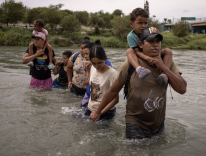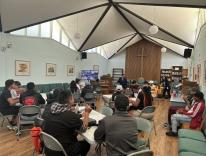“You have picked a bad night to cross,” the man tells the shivering couple in the kitchen, as they watch snow falling outside the window. The other man replies, “Every night is bad.” This observation, recounted in Octavio Solis’s Retablos, a coming-of-age memoir set in El Paso during the sixties and seventies, still applies in the borderland.
At El Paso’s Sacred Heart, the Spanish-speaking Jesuit parish half a mile from the border, hundreds of Venezuelan migrants milled outside the church’s overcrowded shelter, Casa del Sagrado Corazón, spilling out into the alleyway and nearby street corners. Those inside and outside the shelter were all part of a refugee crisis that has pushed past 7 million. With an eye to the thousands of migrants camping out across the border in Ciudad Juárez as well as those already on the streets of El Paso, the mayor declared a state of emergency beginning in May. Anticipating a dangerous surge after the expiration of Title 42 (the provision of federal-health law invoked during the pandemic that expedited the expulsion of migrants), Gov. Greg Abbott sent a “Tactical Border Force” of the Texas National Guard to counter what he sardonically referred to as President Biden’s “laying down of a welcome mat for the entire world.”
On a Sunday in April, a few weeks before Title 42 ended, I was volunteering with my girlfriend at Sacred Heart, beautifying the block after 10 a.m. Mass. As we harvested cigarette butts, Coke cans, and the occasional diaper, some migrants saw us and began to help. A Venezuelan man in his mid-thirties, with a sunburnt, melancholic face and a weathered backpack, trailed behind me for part of the block, picking trash with his bare hands. “¿Qué está pasando en Venezuela?” I asked in gringo Spanish. The man answered simply, “Muy fea allí”: “Very ugly there.”
Life for most people in Venezuela has been ugly for the past decade: political turmoil, food shortages and malnutrition, a collapse of public infrastructure, and a lack of clean water. As liquid pooled at the bottom of our trash bag, I thought of news footage I had seen of hungry Venezuelans sifting through rubbish piles for food. At the end, I offered the man a handshake and “buena suerte,” as he returned to the queue, likely to pass another night in the streets. Canopies of Red Cross blankets and cardboard bedding lined the alleyway between the church and the shelter. I hoped the man might find America less ugly.
Beyond the wall and the Rio Grande, Ciudad Juárez stares back at El Paso. From the University of Texas–El Paso, you see houses arrayed on hillsides, splashed with tropical colors that offset the drabness of cinder block. A city associated in popular imagination with cartels and crime (it features in Breaking Bad and Sicario), Juárez is part of a transborder manufacturing hub that generates about $4 billion annually. It was also the scene of a horrifying fire at a migrant detention center in late March, which killed forty migrants. Most migrants use Juárez as a staging point before crossing into El Paso, adding a layer of complication to the lives of those who cross back and forth across la frontera every day.
As my girlfriend and I drive over the Bridge of the Americas into Juárez, we see a few joggers and families congregating in a park. White-gloved Mexican cops, one impressively smoking a cigarette with no hands, direct traffic at an intersection. We are heading to Clinica Proyecto Santo Niño, a school and health clinic run by the Sisters of Charity in Anapra, an impoverished colonia on the northwest outskirts of Juárez. Paved streets are interspersed with dirt roads, and we have learned to navigate hidden speed bumps and roundabouts made of tires. The first time I came here, sewage spilled into the streets. Further west, miles of border wall span into the Chihuahuan desert, tagged here and there with anti-Trump graffiti.
The façade of Clinica Proyecto Santo Niño is painted bubblegum pink, with a children’s mural depicting the Holy Mother surrounded by angelitas and a boy in a wheelchair. Inside, there are Montessori-style classrooms, a common area, a common bath, and a physical-therapy room. The clinic mostly serves locals with disabilities such as muscular dystrophy, spina bifida, or cerebral palsy. I sometimes assist my girlfriend, who is a physical therapist, but just as often I am simply there, drinking coffee with the mothers, playing with the kids, practicing my broken Spanish—a male presence in an unmistakably maternal atmosphere.
Just being there, I encounter the Christlike beauty of the broken and poor. Mothers carry their disabled children like icons of the pietà, lowering them gently into the waters of the bath. Hands caress and wash damaged muscles in everyday liturgies of hope and healing. Jesús is in his early thirties and comes to the clinic with his affable mother, Monica. A former criminologist, he had a brain tumor that was over-radiated and now he has difficulty walking and speaking. With the help of a translator, I talk with Jesús and Monica after a session, asking them about life in Anapra, about what they might want Americans in Chicago or Seattle to know about their experience on this side of the border. Shy at first, Monica expresses her gratitude to the clinic and the sisters, and to my girlfriend for the physical therapy she provides her son. Only then does Monica speak of the troubles that afflict her and others in Anapra: poverty, corruption, the trafficking and violence of cartels. “You have to have faith, because the devil is here,” she tells me. Monica cares for Jesús full time, while her husband works as a handyman and her youngest son studies to become a nurse. What she wishes for her family is not very different from what most middle-class American parents would wish for theirs: better access to health care, more economic opportunity. But Monica also speaks freely of Christ and the guardian angels who protect her family. Her faith and gratitude give her courage, protecting her against bitterness and despair.
At the Paso del Norte Bridge, a stone’s throw from Sacred Heart, we idle in our car, waiting to pass back into the United States. I watch as a female border-patrol agent strides across the pedestrian walkway, leading recent deportees to the streets of Juárez. Another agent brings up the rear, hand on his holster in an easygoing martial pose. Many Americans believe the situation on the border requires a military response. Gov. Abbott is one of them. He has deployed a “Tactical Border Force,” and tasked thousands of Texas National Guard troops with his “Operation Lone Star.” Fort Bliss, home to seventeen thousand soldiers of the First Armored Division, is also a major player in the economy and culture of El Paso. The border wall, steel-beamed and concertina-wired, can seem like the frontline in a military zone.
Is the crisis at our border a national-security issue or a humanitarian one? These simplistic characterizations seem to be the only ones we are allowed to choose from, but they obscure the systemic nature of the problem. They obscure, for example, the history of U.S. meddling in Latin America. They also obscure the cartel operations bankrolled by drug use across the United States. The average migrant trudging through the Panamanian jungle or sleeping rough in the alleys of El Paso is a victim of these larger forces, for which we bear at least some collective responsibility. Mass migration, like economic globalization and pandemics, points urgently to the interdependence of today’s world. And interdependence without solidarity is a recipe for mass suffering. As the French Catholic poet Charles Péguy wrote, “We must be saved together / We cannot go to God alone; / Else He would ask, / ‘Where are the others?’”
Please email comments to [email protected] and join the conversation on our Facebook page.
Previous Story
Welder of Words
Next Story
ChatGPT’s Corrosion of the Classroom

